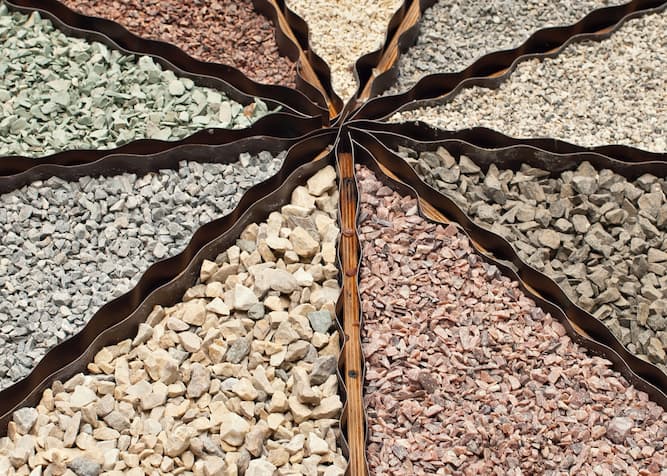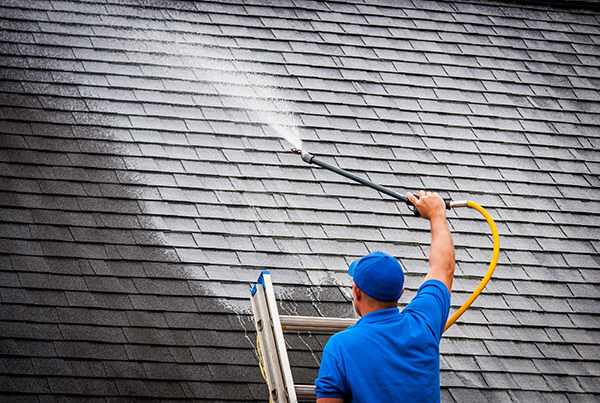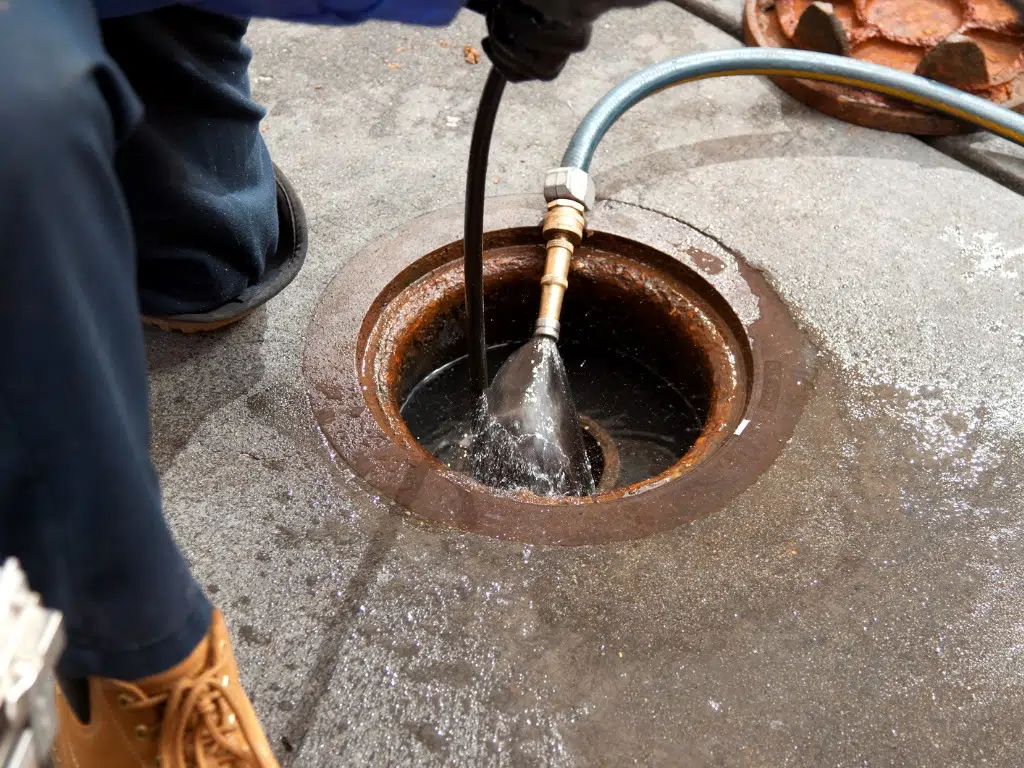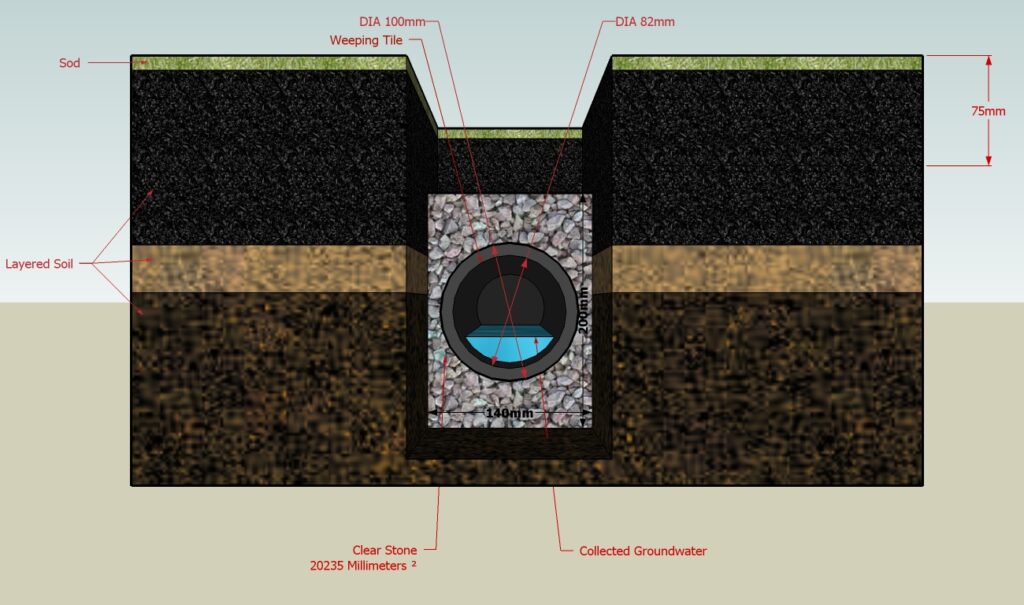Gravel is the ideal choice for managing flooding on your lawn—but there are so many types to choose from. You may have an idea of what you want your yard to look like, but how can you be sure the rock you’ve picked will actually provide the best drainage?
Some types of gravel are better for draining water than others, and some have specific use cases. Let’s take a look at the best gravel and rock for drainage around your house, on your driveway, in your yard, and wherever else on your property you need to manage excess water.
Pea Gravel Is the Best Overall Choice for Drainage
For most residential and commercial landscaping projects that prioritize drainage, pea gravel is the best option. It’s made up of small, smooth stones that are typically the size of a pea. It has a unique size, shape, and loose structure that lets water flow through it easily.
-
- Top layer or foundation: Pea gravel’s rounded shape prevents it from compacting, so it can act as a barrier that directs excess water away from areas prone to flooding.
- Top layer or foundation: Pea gravel’s rounded shape prevents it from compacting, so it can act as a barrier that directs excess water away from areas prone to flooding.
-
- Erosion deterrent: Soil erosion causes you to lose valuable topsoil and damage plants or structures. Pea gravel absorbs water and protects the soil beneath from being washed away.
- Erosion deterrent: Soil erosion causes you to lose valuable topsoil and damage plants or structures. Pea gravel absorbs water and protects the soil beneath from being washed away.
-
- Esthetically versatile: You can get pea gravel in a wide range of colors, making it easy to match the rest of your landscaping. It also adds a softer look to gardens, patios, and walkways.
Why Not Use Pea Gravel?
Pea gravel is pretty versatile, but it’s not always the best choice for every landscaping project. Generally, for walkways, patios, or areas that will see a lot of foot traffic, pea gravel can be less than ideal. Here are some downsides to pea gravel worth considering before you buy it:
-
- Weed magnet: Weeds can easily grow through your pea gravel if you don’t install a weed barrier underneath—and the barrier should cover the entire area where you’re putting pea gravel.
- Weed magnet: Weeds can easily grow through your pea gravel if you don’t install a weed barrier underneath—and the barrier should cover the entire area where you’re putting pea gravel.
-
- Maintenance: Keeping pea gravel clean takes a bit more effort than other alternatives; you’ll have to rake it to keep it level on top and remove debris with a leaf blower.
- Maintenance: Keeping pea gravel clean takes a bit more effort than other alternatives; you’ll have to rake it to keep it level on top and remove debris with a leaf blower.
-
- Pets: If you have a dog or cat that likes to explore outside, they might decide to do their business in your pea gravel. You’ll have to clean up after your pet every time if you don’t want a bad stench hanging around your yard.
Other Types of Good Gravel for Drainage
Pea gravel isn’t your only option for good drainage, however. There are plenty of other gravel, stones, and rocks available to suit your needs and aesthetic preferences.
Decomposed Granite
Decomposed or crushed granite has been weathered so much that it breaks down into small pieces. You can get decomposed granite loose or with stabilizer mixed in—it costs more with stabilizer but it will last longer.
Without a stabilizer, loose decomposed granite will eventually compact and be less effective for draining excess water. It also moves easily, so if it’s placed next your house, you can easily track it inside. Stabilized decomposed granite is also less susceptible to erosion and softer to walk on.
You can also use interlocking permeable pavers with your decomposed granite to maintain its permeability. This type of gravel is most often used for driveways.
River Rock
River rock can come in a wide variety of shapes, sizes, and colors. It refers to any rocks or stones that have been smoothed over by the movement of flowing water. They’re usually found in rivers or stream beds or on beaches.
In landscaping, river rock is often used to install dry creek beds that can help redirect water away from low-lying or easily flooded areas. Since they come in many colors, you can easily make a dry creek bed that matches your landscaping style.
It’s also common to use river rock in French drains because it works well to push water toward an underground well and prevent flooding.
Marble Chips
Marble is a porous material, making it ideal for lawn drainage. You can place marble chips around your plants and flowerbeds to prevent the soil and plants’ roots from becoming over-saturated with water.
Unlike some other gravel and stone options, marble has high thermal conductivity. It absorbs and releases heat quickly, which keeps your soil at just the right temperature. Marble chips are also attractive, so many homeowners use them as a top layer.
Crushed Stone: Is #57 Good Gravel for Drainage?
Crushed granite isn’t the only type of crushed stone you can get for your landscaping project. There are several types of stones or rocks that come in different sizes, ranging from ¾” to 4”” in diameter.
To help make sense of all these varieties, crushed stone is graded and given a number, such as #57 or #8. The grade generally refers to the size of the individual pieces once the stone’s been crushed.
#57 stone is one of the most common because it’s versatile. It’s about ¾” in size and used for driveways and drainage solutions. It’s also durable, making it one of the most cost-effective crushed stones you can get for draining excess water on your property. One of the only downsides to #57 stone is that it’s not the most attractive crushed stone option. Still, many people use it for decorative purposes.
Best Gravel Thickness for Drainage
If you’re placing gravel to promote drainage on your property, it should be at least ½” and not any larger than 1½” in diameter. It depends where you’re using the gravel too. If you’re constructing a French drain, you’ll want gravel that’s at least 1” and possibly larger.
Any gravel smaller than ¼” inch defeats the purpose of using gravel to drain away excess water—it’s too small to have an effect. If it’s larger than 1½-2” it can cause issues with settling water.
What to Put Under Gravel for Drainage
Gravel is an ideal option for directing excess water away from low-lying areas, but you have to ensure you put something underneath it. Non-woven geotextile fabric is the most common choice for this.
If you don’t put anything underneath the gravel, the rocks will simply sink into and mix with the soil, turning it rocky. For gravel pathways, rock gardens, or areas that don’t need much water, get non-woven fabric. For pathways, gravel mulches, or placing behind retaining walls, you can get spun landscape fabric.
Gravel for Specific Needs
The best gravel for your needs might vary depending on what you’re using it for. We wouldn’t recommend the same gravel for driveways as we would for creek beds, for example. Here are our suggestions for the best gravel for different use cases.
-
- Best gravel for drainage around the house: Pea gravel and crushed stone are good for draining near a house’s foundation. They’re less ideal next to doors and walkways, though, as the small, loose stones can be easily tracked inside.
- Best gravel for French drains: Hard rocks like river rock or granite are best for French drains. The gravel pieces should be at least 1” wide.
- Best gravel for driveways: Driveways last longer with crushed stone, generally #57 or #8 stone.
- Best gravel for patios and walkways: Pea gravel is small and smooth, making it ideal for patios or areas with lots of foot traffic.
- Best gravel for plant beds: Decomposed granite and pea gravel work well for gardens and plant beds, although it depends also on your esthetic preferences.
- Best gravel for creek beds and ponds: River rock is a good choice for creek beds, but finer gravel like pea gravel can also work. For ponds, which are full of still water, pea gravel is ideal.
- Best gravel for drainage around the house: Pea gravel and crushed stone are good for draining near a house’s foundation. They’re less ideal next to doors and walkways, though, as the small, loose stones can be easily tracked inside.
Finding the Best Drainage Gravel
Constant flooding on your property can be infuriating. Gravel might be the answer, but only if it’s the right type of gravel and it’s installed properly. After reading this guide to gravel types, you should have an idea of what you need—but it always helps to have a professional opinion.
At Ware Landscaping, we’re lawn drainage experts. We can transform your yard from a soggy mess into a beautiful outdoor space. Our team can help you pick out the best gravel to match your landscaping style, and even install a French drain or other drainage system to keep your lawn healthy year-round.
Contact us for a free quote to discuss your drainage options today.










